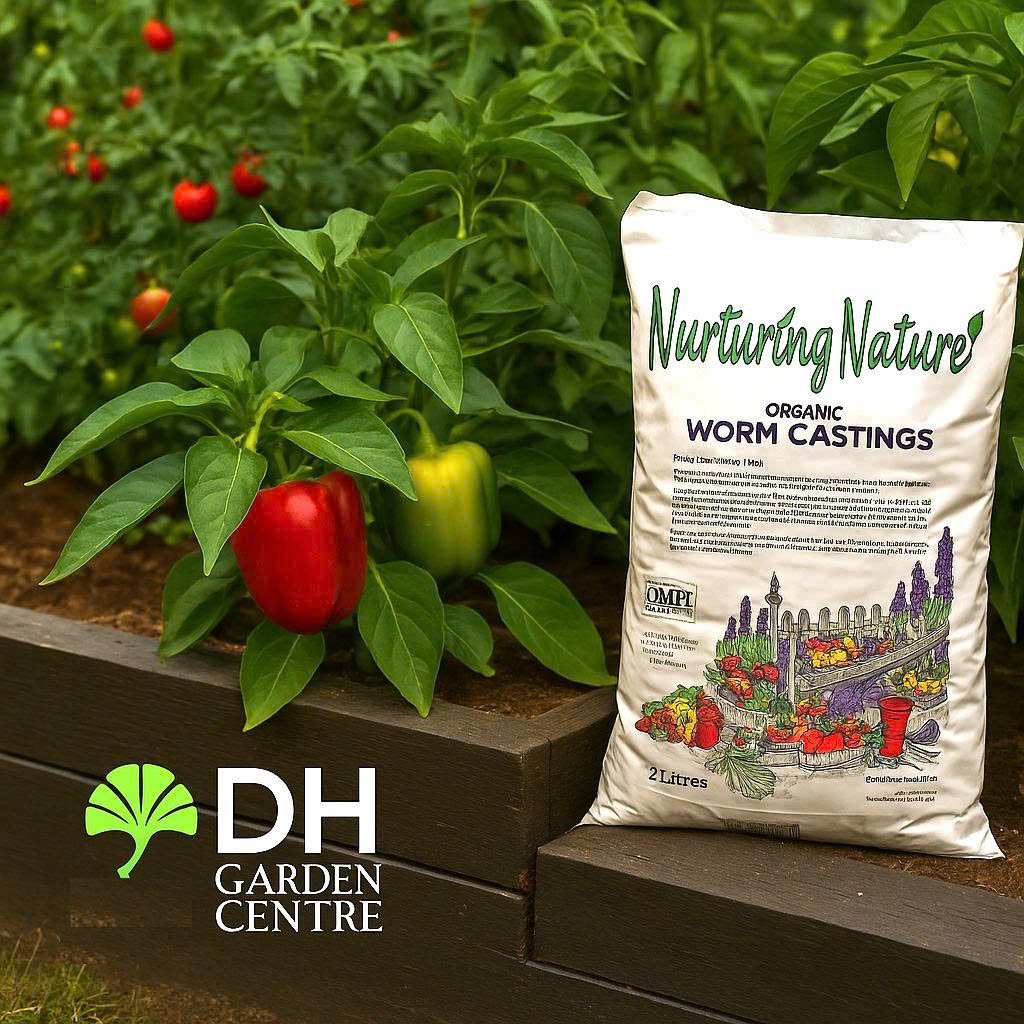The biology behind worm castings – why your soil come alive
In the world of organic gardening, few things are as quietly powerful as worm castings. Often called black gold, worm castings are celebrated not just for what they add to the soil – but how they work.
You see, worm castings don’t behave like typical fertilizers. They don’t dump high doses of synthetic nutrients into your garden. Instead, they act like a soil whisperer gently transforming your growing environment at the microbial level.
Let’s dig deeper (pun intended) into the biology of worm castings, and why they’re far more than just worm poop. They’re a living ecosystem and your plants can feel the difference.

THE BIOLOGY BEHIND WORM CASTINGS – WHY YOUR SOIL COMES ALIVE
1. What’s Really in Worm Castings?
Each teaspoon of worm castings holds billions of living microbes and microscopic organisms that are vital for healthy soil. Here’s a breakdown of what makes worm castings biologically unique:
🔬 Beneficial Microorganisms: From nitrogen-fixing bacteria to mycorrhizal fungi, these microbes break down organic matter, unlock nutrients, and build symbiotic relationships with plant roots.
🌱 Natural Plant Hormones: Auxins, gibberellins, and cytokinins are naturally present in worm castings. These help regulate root development, stem elongation, and leaf expansion—supporting balanced growth.
🛡 Chitinase-Producing Microbes: These organisms produce enzymes that help fight off pests and soil-borne diseases. They’re your plant’s microscopic security team.
🌿 Humic and Fulvic Acids: These powerful compounds increase nutrient uptake, buffer pH, and improve soil structure—essentially making nutrients more bioavailable.
Unlike synthetic fertilizers, worm castings support soil health from the ground up—by feeding the life within the soil instead of bypassing it.
2. Worm Castings as a Living Soil Amendment
Let’s pause for a moment.
When you apply worm castings to your pot or garden bed, you’re not just fertilizing—you’re planting a mini ecosystem.
The microbes in worm castings continue to multiply in your soil, creating a ripple effect that improves:
- Nutrient cycling
- Disease resistance
- Soil aeration and water retention
- Organic matter breakdown
In essence, worm castings don’t feed the plant directly. They feed the soil, which then feeds the plant.
This is why plants grown with worm castings often show:
- Stronger root systems
- More vibrant foliage
- Better resistance to drought and pests
- Increased flowering and fruiting
Worm castings create a self-sustaining loop of soil fertility—something chemical fertilizers can’t replicate.
3. Plant Growth Regulators: Gentle, Natural Boosters
Worm castings contain three major types of plant growth hormones:
- Auxins: Promote root formation and elongation. Essential during transplanting or propagation.
- Gibberellins: Stimulate stem growth, seed germination, and leaf expansion.
- Cytokinins: Encourage cell division and delay leaf aging, resulting in more vigorous plants.
The key difference is balance.
Unlike synthetic hormone supplements that can overstimulate and stress plants, worm castings deliver these in low, steady concentrations—just enough to support healthy, natural growth.
This makes them ideal for seedlings, sensitive houseplants, and organic food crops.
4. Chitinase: Nature’s Pest Control
One of the most fascinating things about worm castings is their effect on plant immunity.
Certain microbes found in worm castings produce an enzyme called chitinase. This enzyme breaks down chitin—the primary substance in the exoskeletons of many pests like fungus gnats, aphids, and root-knot nematodes.
What does this mean for your garden?
- Fewer fungal diseases like damping-off or powdery mildew
- Less root rot in overwatered pots
- Natural protection from harmful insects
It’s not a pesticide—but it helps create an environment where pests and pathogens struggle to survive.
5. Humic Acids and Improved Nutrient Uptake
Humic acids are naturally formed during the breakdown of organic matter and are abundant in worm castings. They serve multiple roles:
- Improve cation exchange capacity (CEC), helping soil hold onto nutrients
- Stimulate root development and branching
- Detoxify heavy metals in the soil
- Enhance microbial diversity
Think of humic acid as a nutrient unlocker. It helps free up bound minerals in the soil—like iron, calcium, and magnesium—making them easier for plant roots to absorb.
6. Microbial Biomass: Real Research, Real Results
Let’s back it up with science.
A 2020 study published in Applied Soil Ecology tested worm castings in vegetable gardens across varying soil types. The results were dramatic:
- Microbial biomass increased by up to 300% within 14 days
- Soil respiration rates doubled, indicating healthy biological activity
- Plants showed greater resilience during drought stress
Another trial from a greenhouse tomato farm in British Columbia added just 10% worm castings to potting media. They reported:
- 30% faster germination
- Stronger stem and root development
- Lower incidence of root disease and blossom-end rot
These aren’t anecdotal claims—they’re quantifiable improvements in plant performance thanks to worm castings.
7. Why Microbes Matter More Than Macronutrients
It’s easy to obsess over N-P-K ratios (Nitrogen-Phosphorus-Potassium). But truly healthy plants rely just as much on biological interactions in the soil.
Worm castings support these vital interactions:
- Mycorrhizal fungi form networks that expand root access
- Nitrogen-fixing bacteria convert atmospheric nitrogen into usable forms
- Decomposer microbes break down dead organic matter into humus
This is what we call living soil—a self-renewing system where nutrients are always being recycled and made available to plants in just the right amount.
8. A Microbial Symphony for Every Garden
Whether you’re growing heirloom tomatoes in raised beds or ferns in a shaded corner of your living room, worm castings bring biological intelligence to the soil.
And the best part?
Worm castings are:
- pH neutral and safe for all plant types
- Odorless (they smell like fresh forest soil)
- Non-toxic to kids, pets, pollinators, and aquatic life
- Easy to use and store
This makes them ideal for:
- Organic gardening
- Indoor plant care
- Sustainable agriculture
- DIY soil mix recipes
At DH Garden Centre, we recommend worm castings for everything from monstera to mint, roses to rosemary. And our customers across Vancouver can see the difference in their plants—greener, healthier, stronger.
9. How to Support the Biology in Your Worm Castings
Because worm castings are alive, they deserve care:
- Avoid over-drying: Store in breathable containers (fabric or paper)
- Use dechlorinated water when brewing worm tea
- Don’t mix with synthetic fertilizers—they can harm the microbes
- Apply regularly but lightly—a little goes a long way
Remember: you’re not just feeding your plants. You’re feeding an underground city of helpers.
Final Thoughts: Soil Is More Than Dirt
When we look at soil as just a physical medium for roots, we miss the magic. Real gardening begins when we recognize that soil is alive—and our job is to care for that life.
Worm castings bring life to even the most tired, depleted, or inert soils. They start a biological chain reaction that leads to vibrant, disease-resistant, nutrient-dense plants.
So the next time you’re planning your garden—or simply repotting a struggling fern—remember: a handful of worm castings could be the smartest thing you add to your mix.
📍 Visit DH Garden Centre in Vancouver (3742 West 10th Avenue) to shop premium, organic worm castings—locally sourced and gardener-approved. 🛒 Can’t visit? Order online at dhgardencentre.com 📩 Subscribe to our newsletter for monthly soil tips, exclusive discounts, and how-to guides on building your own living soil ecosystem.
Grow smarter. Grow biologically. Grow with worm castings.

